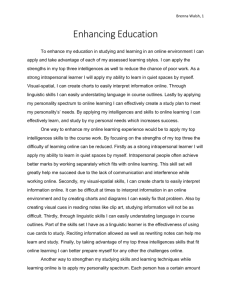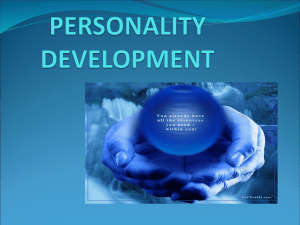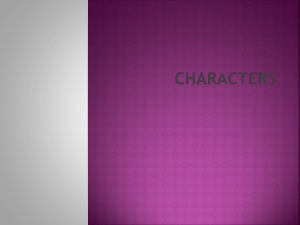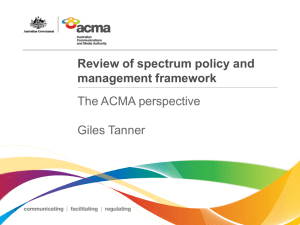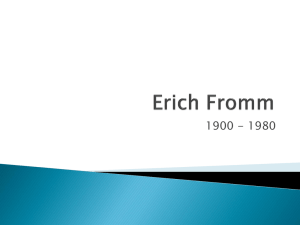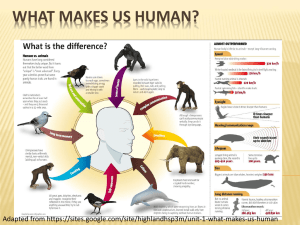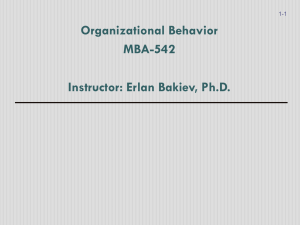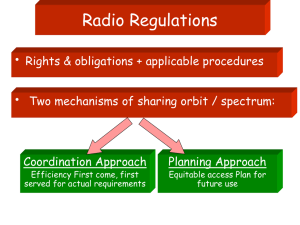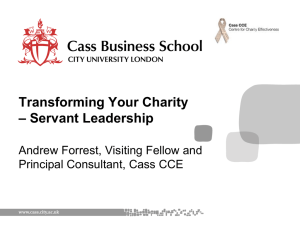Success Chapter 3, pg 66
advertisement
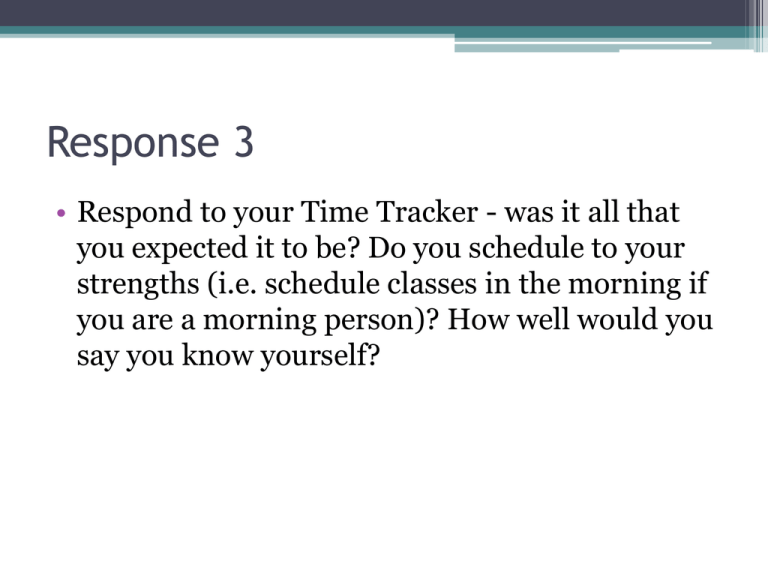
Response 3 • Respond to your Time Tracker - was it all that you expected it to be? Do you schedule to your strengths (i.e. schedule classes in the morning if you are a morning person)? How well would you say you know yourself? Success Chapter 3, pg 66 Teri Tosspon, M.A. Heald College Situation Puzzles • Get into groups of 4-5 • Try to solve as many puzzles (on the handout) as you can Situation Puzzle Answers 1. The backpack is a parachute that failed to open 2. The man is a dwarf/little person and can only reach to the 10th floor 3. The man had the hiccups and the bartender scared them out of him 4. Sunday is a horse 5. The man is a justice of the peace, marrying the women to other men. Why explore who you are as a learner? • Because your GPA is not WHO you are • Your unique intelligence can change and develop ▫ Picture a bag of rubber bands ▫ Some are thin, some thick Some are short, some long ▫ BUT all of them can stretch • Assessments can help you learn about yourself • Self-knowledge is an important, lifelong goal. What tools can help you assess how you learn and interact with others? • Assess your Multiple Intelligences with Multiple Pathways to Learning ▫ Howard Gardner ▫ 8 Unique intelligences – areas of ability • ADSF Two self-assessments Multiple Intelligences • Learning Preferences • What abilities and areas of learning come most easily to you Personality Spectrum • Personality Traits • How you interact with information and people Assess yourself: Multiple Intelligences • Multiple Pathways to Learning (pg 72) • Rate EACH STATEMENT on a scale of 1-4 ▫ 1 is the lowest ▫ 4 is the highest • Complete the chart on page 73 • When you complete the task, look at Key 3.2 on pg 74. • Turn to a partner and discuss: Which are your strengths? How can you use this information to help you learn? How can you discover how you learn? Multiple Intelligences • • • • • • • • Verbal-Linguistic: Listening, reading, writing, speaking Logical-Mathematical: Math, science, patterns, sequences Bodily-Kinesthetic: Coordination, working with hands Visual-Spatial: Visual art, graphics, charts, maps Interpersonal: Social activity, cooperative learning, teamwork Intrapersonal: Self-awareness, independence Musical: Music, sound sensitivity, patterns Naturalistic: Interest in nature, ecosystem Personality Spectrum • Carl Jung ▫ Individual’s preferred “world” introverts/extrovert ▫ Different ways of dealing with the world • Briggs-Meyers – 16 “types” • Keirsy-Bates: The Personality Spectrum ▫ ▫ ▫ ▫ Thinker Organizer Giver Adventurer How can you discover how you learn? Personality Spectrum • • • • Thinker: Giver: Organizer: Adventurer: Analytical, problem solver Authentic, communicator Responsible, detailed Daring, spontaneous Assess yourself: Personality Spectrum • Personality Spectrum (pg 76) • Put each question (1-8) in ORDER of the one most like you (4) to the one least like you (1) ▫ DIFFERENT THAN THE MI NUMBERING • Complete the chart on page 77 • When you complete the task, look at Key 3.3 on pg 78. • Turn to a partner and discuss: Which are your strengths? How can you use this information to help you learn? Personality Spectrum: Example Directions: Rank order all four responses to each question from most like you (4) to least like you (1) so that you use the numbers 1, 2, 3, and 4 one time each. Write numbers in the boxes next to the responses. I learn best when the material is a. well organized. b. something I can do hands-on. c. about understanding and improving the human condition. d. intellectually challenging. Scoring Plot Personality Spectrum scores on this diagram. How Can You Use Your Self-Knowledge? • Classroom Benefits ▫ Play to your strengths ▫ Work to strengthen weaker areas ▫ Ask your instructor for help • Study Benefits ▫ Helps you pick the right strategies ▫ Helps you understand others you are studying with • Workplace Benefits ▫ Better performance and teamwork ▫ Better career planning Personality Spectrum Activity • Get into groups by your Personality Spectrum strengths ▫ Thinker, Organizer, Giver, Adventurer ▫ Go to the group that you scored highest in. If you “tied” in 2+areas, wait until groups are seated then join the smaller group) ▫ Introduce yourselves • Develop a poster answering questions 1-5 on pg 92 • Be ready to present your info to the class. Maximizing your Classroom Experience • Get into groups based on your MI • Using the chart on pg 82-83, develop a plan to utilize your strengths in the classroom and studying. Answer these questions in your notes: 1. How can you get along with a teacher and a teaching style 2. How can you get the most out of your classroom learning 3. How can you study effectively 4. How ca you solve any major problem Develop a symbol: Remember your 8 intelligence? • In the same MI groups, use YOUR strengths to develop a symbol to help you remember all of the Multiple Intelligence (MI)’s Understanding Teaching Styles • Lecture, verbal focus • Lecture with group discussion • Small groups • Visual groups • Logical presentation • Random presentation • Conceptual presentation • Detailed presentation • Experience-based presentation Assignment • • • • In your Multiple Intelligence (MI) group Develop a list of the ways your MI procrastinates Come up with solutions to those procrastinations Prepare a presentation for the class (due next week) for a game we will play ▫ ▫ ▫ ▫ Should be no more than 2-5 minutes long! Can be a skit demonstrating procrastination/how not to Can be a chart, list, etc Everyone in your group MUST speak. How Can You Identify and Manage Learning Disabilities? • Identifying a Learning Disability • Managing a Learning Disability Thinking Successfully About How You Learn • Analytical Thinking – analyze your levels of ability with the Pathways to Learning selfassessment and examine how you relate to people and the world around you with the Personality Spectrum assessment. • Creative Thinking – brainstorm how to relate to instructors who teach differently than you learn. • Practical Thinking – utilize practical study strategies relating to your own Personality Spectrum and Multiple Intelligence dimensions. Oruko lonro ni In the language of the Yoruba, an ethnic group living primarily in Nigeria and other West African countries, oruko lonri ni translates as “names affect behavior.” This belief, common among the Yoruba people, refers to the idea that people live up to the names given to them by others or even chosen by themselves. How would you apply this word to your life? “…no two selves, no two consciousnesses, no two minds are exactly alike. Each of us is therefore situated to make a unique contribution to the world.” Howard Gardner, Psychologist and Educator Homework • • • • Chapter 3 (read) 2 Minute Presentation on your MI Planner 3 Portfolio 3 ▫ sample on pg 93 & handout. ▫ You MUST have the at least these 5 categories: Personality Spectrum (scores & what they mean) Multiple Intelligences (Scores & what they mean) Values/Goals Your Choice: Interests/Hobbies Your choice: Career Interests, Personal Diversity, etc • Higher • Interpersonal-23 • Verbal/Linguistic – 22 • Naturalistic – 22 • Logical/Math – 21 • Intrapersonal 21 •Higher • Lower •Adventurer – 23 • Visual/Spatial – 15 •Imaginative • Musical - 12 •Artistic •visual •Thinker – 22 •Technical •Logical •objective Personality •Giver – 21 Spectrum •Caring •Sociable •Feeling •adaptable •Lower •Organizer - 14 •Tactical •Planning • Playing games •Structured • Reading/writing • Painting • Pets • Gardening • cooking Multiple Intelligences Interests & Hobbies • Education • Self-knowledge/ improvement • Helping/ respecting others • Honesty • Relaxation time •Teaching •Writing books •Painting Values Career interests Teri Tosspon Self-Portrait: Think-Link Intelligences Verbal/ Linguistic - 22 Inter- • persona l - 23 • Relate to others teamwork Logical/ Math 21 Naturalist ic – 22 Intrapersona l - 21 Visual/ Spatial-15 Musical - 12 Personality Spectrum Adve • Imaginative Thinker – 22 nture • Artistic r - 23 • Visual •Technical •Logical •objective Give r– 21 Organize r - 14 • • • • Tactical Planning Structured Dependable • • • • Caring Sociable Feeling adaptable Career Interests Writing Helping others Creativity Teaching! Interests/Hobbies Playing Games Visuals/ websites Painting & Drawing Reading & Writing Cooking / Baking My dog ‘Nilla

